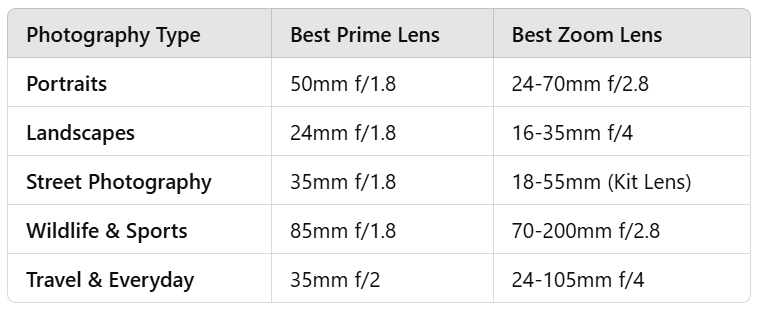Prime vs. Zoom Lenses: Pros and Cons
Introduction
Choosing between prime lenses and zoom lenses is one of the biggest decisions photographers face. Both lens types have their strengths and weaknesses, and the best choice depends on your photography style, budget, and creative needs.
This guide will break down the differences, advantages, and disadvantages of prime vs. zoom lenses to help you choose the best lens for your photography.
1. What is a Prime Lens?
A prime lens has a fixed focal length (e.g., 35mm, 50mm, 85mm) and cannot zoom in or out.
✔️ Examples of Prime Lenses:
50mm f/1.8 (Great for portraits, everyday use)
35mm f/1.4 (Best for street photography)
85mm f/1.8 (Perfect for professional portraits)
📌 Prime lenses force you to move around to frame your shot, encouraging better composition skills.
2. What is a Zoom Lens?
A zoom lens has a variable focal length (e.g., 18-55mm, 70-200mm) and lets you zoom in and out without changing lenses.
✔️ Examples of Zoom Lenses:
18-55mm f/3.5-5.6 (Kit Lens) – Versatile for beginners
24-70mm f/2.8 – Excellent for professional photography
70-200mm f/2.8 – Perfect for sports and wildlife
📌 Zoom lenses are convenient for dynamic scenes where moving closer isn’t an option.
3. Prime vs. Zoom Lenses: Key Differences
Prime vs. Zoom Lenses
📌 Prime lenses offer better image quality and low-light performance, while zoom lenses provide more versatility.
4. Pros and Cons of Prime Lenses
✅ Pros of Prime Lenses
✔️ Better Image Quality – Sharper and less distortion.
✔️ Wider Apertures (f/1.2 – f/2.8) – Better low-light performance and beautiful background blur.
✔️ Smaller and Lighter – Easier to carry around.
✔️ Encourages Creativity – Forces you to move and frame shots manually.
✔️ More Affordable – Budget-friendly options available (e.g., 50mm f/1.8).
🚫 Cons of Prime Lenses
❌ Fixed Focal Length – Need multiple lenses for different compositions.
❌ Less Versatile – Must switch lenses for different shots.
❌ Can Be Limiting for Fast-Paced Photography – Harder to use in events or action photography.
📌 Best Prime Lens for Beginners: 50mm f/1.8 (a must-have for portraits and low light).
5. Pros and Cons of Zoom Lenses
✅ Pros of Zoom Lenses
✔️ More Versatile – Covers multiple focal lengths in one lens.
✔️ Great for Travel & Events – Avoids carrying multiple lenses.
✔️ Convenient for Sports & Wildlife – Zoom in on distant subjects.
✔️ Easier for Beginners – Less need to move for framing.
🚫 Cons of Zoom Lenses
❌ Narrower Apertures – Less light enters (except f/2.8 zooms).
❌ Larger and Heavier – Can be bulky, especially professional zooms.
❌ More Expensive – High-quality zooms (e.g., 24-70mm f/2.8) cost more than primes.
❌ Slightly Less Sharp – More lens elements can reduce image sharpness.
📌 Best Zoom Lens for Beginners: 18-55mm f/3.5-5.6 (Kit Lens).
6. Which Lens Type is Best for You?
📸 Choose a Prime Lens If You Want:
✔️ Sharper images and better low-light performance
✔️ A lightweight, compact setup
✔️ Blurry backgrounds (bokeh) for portraits
✔️ To improve composition skills
✔️ Best for: Portraits, street photography, artistic shots, low-light photography.
📸 Choose a Zoom Lens If You Want:
✔️ Versatility to shoot different scenes without changing lenses
✔️ A travel-friendly all-in-one lens
✔️ Convenience for action, sports, and wildlife photography
✔️ The ability to adjust framing instantly
✔️ Best for: Travel, events, wildlife, sports, everyday photography.
7. Best Prime & Zoom Lenses for Beginners
Best Prime & Zoom Lenses for Beginners
📌 The 50mm f/1.8 prime and the 18-55mm kit zoom lens are great for beginners!
8. Final Verdict: Should You Get a Prime or Zoom Lens?
✔️ Get a Prime Lens If:
You want better image quality and low-light performance.
You prefer lighter, more compact lenses.
You shoot portraits, street photography, or artistic shots.
✔️ Get a Zoom Lens If:
You want more versatility without changing lenses.
You shoot travel, events, sports, or wildlife.
You need convenience over ultimate sharpness.
📌 For the best setup, start with both a prime (50mm f/1.8) and a zoom (18-55mm kit lens).
Conclusion: Pick the Right Lens for Your Photography Needs
Both prime and zoom lenses have their advantages. If you value image quality and low-light performance, go with a prime lens. If you prefer flexibility and convenience, a zoom lens is the better choice.
✔️ Beginner Setup Recommendation:
✅ 50mm f/1.8 (for portraits & low-light)
✅ 18-55mm Kit Lens (for versatility & everyday use)
📌 Choose the lens that best suits your photography style—and start shooting!


